Trees Birds Mammals Fish Amphibians Reptiles
Wild Algarve
Bookshop
Russula praetervisa Sarnari - Bypassed Brittlegill
Phylum: Basidiomycota - Class: Agaricomycetes - Order: Russulales - Family: Russulaceae
Distribution - Taxonomic History - Etymology - Identification - Culinary Notes - Reference Sources
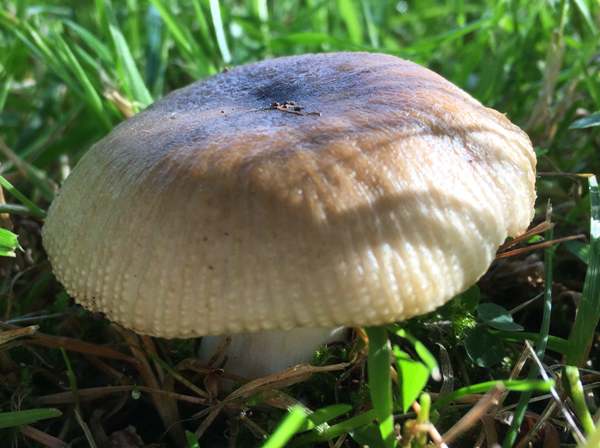
The genus Russula contains many groups of superficially similar species, often with cap colours that are very variable from sample to sample thus making identification from macroscopic characters alone difficult and in some instances impossible. Although Russula praetervisa is an attractive brittlegill, careful microscopic and chemical testing is necessary to separate this species from several other similar brittlegills such as Russula amoenolens (which has a darker cap) and Russula pectinata (which has a more acrid and unpleasant taste).
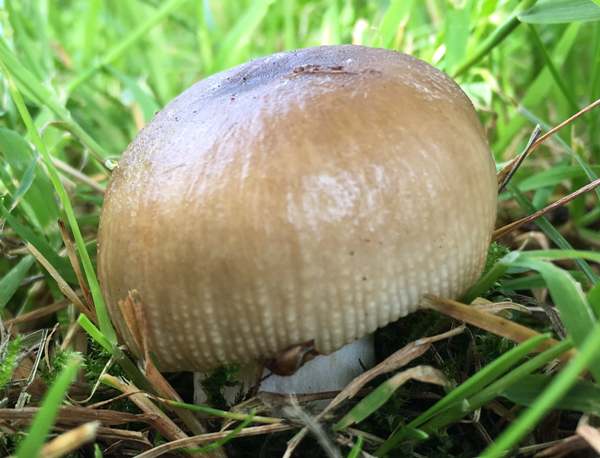
Distribution
This brittlegill is widespread but uncommon in Britain and Ireland as well as on mainland Europe, including Germany, France, Italy and Spain.
Taxonomic history
Russula praetervisa was given its current name in 1998 by Italian mycologist Mauro Sarnari, who is widely regarded as Europe's leading authority on the genus Russula. (Some authorities refer to this brittlegill by its synonymous scientific name Russula pectinatoides Peck., which is described from North America and may not, therefore, be cospecific with Russula praetervisa found in Europe. DNA sequencing might be necessary to resolve this uncertainty.)
Etymology
Russula, the generic name, means red or reddish, and indeed many of the brittlegills have red caps (but many more are not, and several of those that are usually red can also occur in a range of other colours!). The specific epithet praetervisa comes from Latin: Praeter- meaning beyond, and -visum, meaning seen. The implication, I infer, is that this species is similar to but beyond the range of variability of another similar species (perhaps a reference to Russula pectinata, with spores having noticeably less complete reticules and flesh that tastes much hotter.)
Identification guide
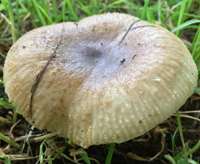 |
Cap
Various shades of yellowish brown, sometimes with an olive tinge; convex, flattening with a slightly depressed centre, which is usually darker than outer region. The surface is mostly smooth and is viscid when wet; towards the margin striations made up of rows of low bumps (pectinate, like the ends of the teeth of a comb).
The cap flesh is white, and caps peel up to 2/3. |
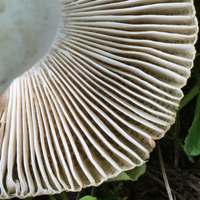 |
Gills
Pale cream or yellowish, becoming light ochre when old; adnexed; fairly crowded; some gills bifurcated (branching) near to the stem. |
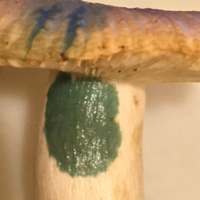 |
Stem
White, often with reddish-brown or purplish rusty spots towards the base; cylindrical or slightly tapering towards the base; 3 to 5cm long and 0.5 to 1.5cm diameter.
Chemical Tests
Guaiac gives a strong positive (deep blue-green) reaction (left).
FeSO4 gives a rose pink reaction. |
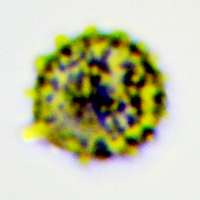 |
Spores
Ellipsoidal, 7-8.5 x 5.6-7µm, covered with warts up to 0.7µm tall many of which are joined by ridges to form an incomplete reticulum (a zebroid partial network).
Spore print
Dark cream. |
Odour/taste |
Odour variously described as like old or burnt rubber, oily or sometimes fishy; taste oily but mild or only very slightly bitter (never strongly acrid). |
Habitat & Ecological role |
Solitary or in small groups mainly in broadleaf and mixed woodland, most commonly with oaks but also recorded under limes and occasionally conifers. |
Season |
July to October in Britain and Ireland. |
Similar species |
The Charcoal Burner, Russula cyanoxantha sometimes displays yellowish brown cap hues, but it produces a white spore print and is notable for its extremely pliant (compared with other Russula fungi) gills. |
Culinary Notes
For those with the experience to identify them with absolute accuracy, apart from a few notorious exceptions (mainly red-capped and white-capped species) most brittlegills are edible mushrooms although some of them reported to be of only mediocre quality. As with all fungi, however, none should be eaten unless identified to species level with 100% certainty.
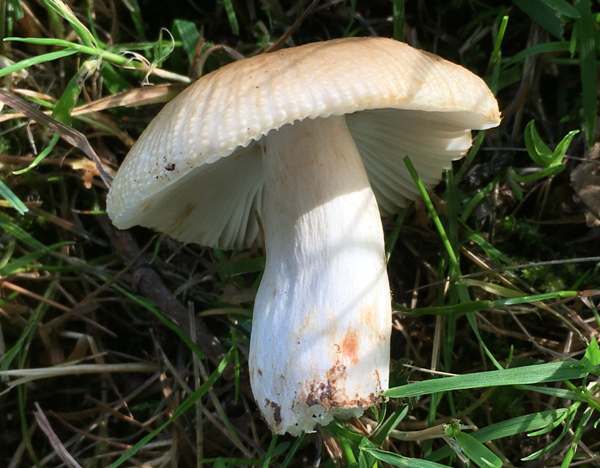
Reference Sources
Pat O'Reilly (2016). Fascinated by Fungi, 2nd edition, First Nature Publishing.
Sarnari, M. (2005) Monografia illustrata del Genere Russula in Europa. Tomo Secondo. AMB, Centro Studi Micologici, Trento.
Geoffrey Kibby (2011).The Genus Russula in Great Britain, published by G Kibby.
Roberto Galli (1996). Le Russule. Edinatura, Milan.
BMS List of English Names for Fungi
Paul M. Kirk, Paul F. Cannon, David W. Minter and J. A. Stalpers. (2008). Dictionary of the Fungi; CABI.
Taxonomic history and synonym information on these pages is drawn from many sources but in particular from the British Mycological Society's GB Checklist of Fungi.
Acknowledgements
This page includes pictures kindly contributed by Simon Harding.
Top of page...
Fascinated by Fungi. Back by popular demand, Pat O'Reilly's best-selling 450-page hardback book is available now. The latest second edition was republished with a sparkling new cover design in September 2022 by Coch-y-Bonddu Books. Full details and copies are available from the publisher's online bookshop...